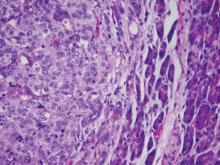The Food and Drug Administration announced on August 17 the approval of vemurafenib, a highly anticipated metastatic melanoma therapy that targets the BRAF V600E mutation found in 40%-60% of patients.
The agency also approved the cobas 4800 BRAF V600 Mutation Test, a companion diagnostic test designed to help determine if a patient’s melanoma cells carry the BRAF V600E mutation.
Vemurafenib is the second therapy to prolong the lives of patients with metastatic melanoma. The first, a slow-acting immunotherapy called ipilimumab (Yervoy), was approved in March 2011.
Clinical trials have shown that vemurafenib (better known as PLX4032) can produce rapid remission in patients at risk of death from metastatic melanoma.
Vemurafenib is not a panacea, as only about half of patients with BRAF V600E mutations have responded, and in the early studies almost all eventually relapsed. However, the drug has produced delays in recurrence and prolongations of overall survival that are clinically and statistically significant.
"This is a bright day for many melanoma patients," Dr. Jeffrey A. Sosman, a professor of medicine at Vanderbilt-Ingram Cancer Center in Nashville said in response to the FDA announcement.
"But it is only the start, and we have to continue to enroll patients onto clinical trials in order to build upon this exciting advance. It is only the beginning," added Dr. Sosman, an investigator in the BRIM-3 trial that led to approval of vemurafenib.
Early results of the pivotal phase III BRIM-3 trial, presented at the American Society of Clinical Oncology (ASCO) in June, and published simultaneously in the New England Journal of Medicine (2011;364:2507-16) , showed that vemurafenib reduced the relative risk of death by 63% in comparison with dacarbazine (DTIC), a standard but ineffective therapy, at a median follow-up of 3 months.
The randomized, open-label study screened 2,107 patients with unresectable stage III or IV melanoma for BRAF mutations, which were found in 47% of patients. It accrued 675 patients from January 2010 though December 2010, but some had not been in the study long enough to be included in the reports, as the trial was stopped based on early positive results.
Among the findings were estimates that 84% of patients treated with oral vemurafenib but only 64% of those given DTIC would be alive at 6 months. Vemurafenib’s hazard ratio for death was 0.37 (P less than .0001). An analysis of progression-free survival showed a 74% reduction in the risk of progression (HR 0.26, P less than .0001).
Median time to progression was 5.3 months with vemurafenib versus 1.6 months with DTIC, Dr. Paul Chapman of Memorial Sloan-Kettering Cancer Center in New York City and colleagues reported. Median overall survival had not been reached in the vemurafenib arm of BRIM-3, but Dr. Chapman expressed optimism that the advantage would hold up over time, as the Kaplan Meier survival curve mirrored results from the precursor BRIM-2 trial.
In that phase II study, median overall survival also had not yet been reached with 77% of patients alive at 6 months and 58% at 12 months, Dr. Antoni Ribas of the Jonsson Comprehensive Cancer Center in Los Angeles reported at the ASCO meeting. His presentation was based on a median follow-up of 7 months with an overall response rate of 53%.
The investigators also looked at patients who had BRAF mutations other than V600E, and were encouraged to find about half responded to vemurafenib, Dr. Chapman said in an interview.
In yet another presentation at ASCO, Dr. Alexander M. Menzies of the Melanoma Institute Australia reported that BRAF mutations are more common in younger melanoma patients. In all, 46% of 311 advanced melanoma patients had a BRAF mutation; 73% of these were V600E mutations, 19% V600K, and the remainder other forms.
The mutation rate declined from more than 80% of melanoma patients aged 20-40 years to 50% of those aged 41-70 years, and to less than 25% of those older than 70 years, Dr. Menzies said. The V600E mutation predominated in younger patients, occurring in 86% of those aged 20-30 years, whereas the V600K mutation emerged in older age.
Vemurafenib - approved at a recommended dose of 960 mg orally twice daily - has a manageable side effect profile, according to the BRIM-3 investigators. Although the safety data were not formally pooled, investigators said less than 10% of patients on active therapy had a grade 3 or higher toxicity. Joint pain, photosensitivity, and skin rashes were the most common. About 20% of patients developed cutaneous squamous cell carcinoma, but it was easily removed by dermatologists, and there were no instances of metastases. Only 6% of patients on vemurafenib discontinued because of adverse events.


